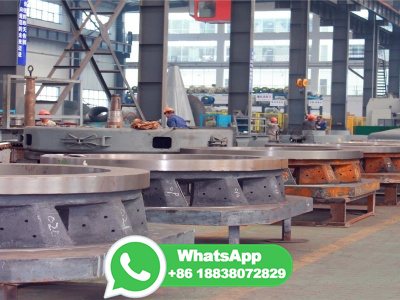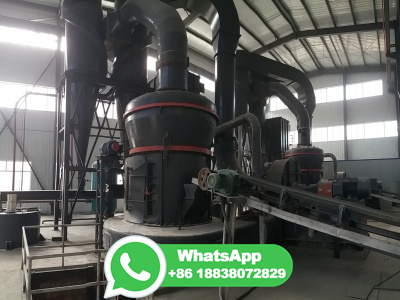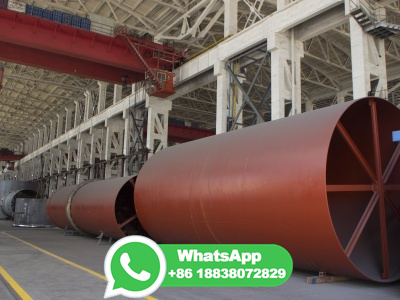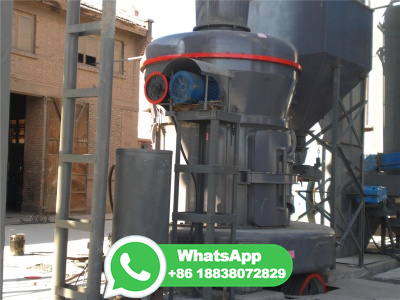
WEBNov 30, 2022 · The original coal seam is rich in pores and fractures, where the methane (CH 4) widely 4 is a great safety threat in coal mine production because of its inflammable and explosive property. Generally, CH 4 in coal seams is treated by drilling and extraction before coal seam mining. Since CH 4 is a clean energy source, the gas .
WhatsApp: +86 18203695377
WEBSep 1, 2021 · The general production process of the activated carbon. The activated carbon production is a typical twostep process, which is composed of carbonization and steam activation stages [31, 32].Both carbonization and activation reactions occur in rotary furnaces as shown in Fig. raw biomass (wood chips) is fed into the carbonization .
WhatsApp: +86 18203695377
WEBJun 2, 2020 · The goal of this study was to upgrade fuel properties of two different bituminous coal wastes (CW) by reducing their ash, sulfur, and chloride content through cohydrothermal carbonization (coHTC) with food waste (FW). CW and FW were mixed in 1:1 (dry wt. basis), ratio and coHTC experiments were performed at three different .
WhatsApp: +86 18203695377
WEBAug 15, 2014 · The behavior of chlorine during cocarbonization of coal and chloride compounds such as PVC in cokemaking process both on a laboratory scale and commercial scale was investigated.
WhatsApp: +86 18203695377
WEBJul 1, 2021 · To expand the scope of coking coal resources and realize the efficient utilization of different types of coking coals, mediumhigh sulfur fat coal (FC1, FC2) and lowsulfur meager coal (MC) were selected to explore the influence of cocarbonization process on the final coke properties.
WhatsApp: +86 18203695377
WEBCoal Plant Matter, Carbonization, Sedimentary Rocks: It is generally accepted that most coals formed from plants that grew in and adjacent to swamps in warm, humid regions. Material derived from these plants accumulated in lowlying areas that remained wet most of the time and was converted to peat through the activity of microorganisms. (It should .
WhatsApp: +86 18203695377
WEBThe factors that affect the adsorption process on activated carbon are, the interaction of the metal ion and its structure, the pH of the solution and the point of zero charge, the porosity and surface area, the surface oxygen functionality and the size ions (typically – nm), with substantial volumes of tapered microporosity (Bian et al ...
WhatsApp: +86 18203695377
WEBDec 1, 2013 · The fate of sulfur during carbonization at 3 °C/min of seven caking coals with carbon and sulfur contents of 80–88 and – mass%daf, respectively, has been studied using a flowtype fixedbed quartz reactor to examine its effect on coal fluidity in caking coal. transfers to H 2 S or tarS from 200 to 350 °C, and FeS 2 .
WhatsApp: +86 18203695377
WEBQ. Explain the process of carbonisation and how coal is formed? [5 MARKS] Q. The temperature at which plastic layer formation takes place during carbonisation of coal varies from: Q. Carbonisation is the process in which dead plants and vegetation is converted slowly into coal. Q. Explain the process of carbonisation. [2 MARKS] Q.
WhatsApp: +86 18203695377
WEBAug 12, 2021 · Coal tar pitch is a thermoplastic composed of thousands of polycyclic aromatic hydrocarbons, and heterocyclic compounds and exhibits a high char yield due to its carbon content . Coal tar and petroleum pitch are relatively cheap to source as they are byproducts from distillation and thermal degradation processes.
WhatsApp: +86 18203695377
WEBHerein, a better mesophase pitch as precursor for the manufacturing of green needle coke is obtained by a new process, whereas the refined medium and lowtemperature coal tar pitch (RCTP) is obtained by a solvent sedimentation method, and then, it is cocarbonized with coalbased hydrogenated diesel oil at 420 °C for 6 h.
WhatsApp: +86 18203695377
WEBJan 21, 2019 · Coal liquefied pitch (CLP) was prepared by the method of solvent extraction–hot filtration–distillation with the coal liquefied residue as the raw material. As one of the preconceived raw material to produce highquality coalbased carbon material, the changes of structure of CLP during liquidphase carbonization process have been .
WhatsApp: +86 18203695377
WEBFeb 15, 2024 · Due to its fine particle size, it is generally used as an adsorbent or soil remediation agent [19], [20]. This does not utilize its properties and advantages as a fuel. Meanwhile, its finer particle size and better carbonization properties allow it to be coal tar pitch's carbonization substrate (skeleton role) [21], [22].
WhatsApp: +86 18203695377
WEBHydrothermal carbonization is a thermochemical process for the pretreatment of high moisture content biomass under hot compressed water, making it applicable for diversified purposes. It is performed in a closed reactor at a temperature range of 180–280°C under pressure (2–6 MPa) for 5 to 240 min ( Arellano et al., 2016 ).
WhatsApp: +86 18203695377
WEBMar 16, 2022 · Previous studies have focused on the activation process, and less on the carbonization process. In this paper, the pyrolysis carbonization characteristics of two activated carbon raw materials were studied based on TGFTIR, and the volatiles released at different heating rates were also analyzed.
WhatsApp: +86 18203695377
WEBOct 1, 2023 · This suggests that coal undergoes a process of carbon atom enrichment and heteroatom removal during carbonization due to the instability of organic matter, a process similar to the upgrading of coal in nature[31]. FTIR was carried out to describe the variation in molecular structure and functional groups during carbonization (Fig. 1d).
WhatsApp: +86 18203695377
content of wood at the time of carbonization. of carbonizing equipment used. with which the process is carried out. WHAT HAPPENS DURING CARBONIZATION. During the carbonization process the wood is heated in the closed vessel away from the oxygen of the air or else the wood can be burnt into .
WhatsApp: +86 18203695377
WEBMay 1, 2014 · The study describes the effect of silicon carbide (SiC) nanopowder on the process of coal tar pitch thermal decomposition during heat treatment to a temperature of 2000 ° influence of nanosized SiC powder on the pyrolysis mechanism of carbonisation product yield, as well as structural and microstructural parameters of .
WhatsApp: +86 18203695377
WEBJun 1, 2022 · As shown in Fig. 7, untreated coal did not exhibit any flame throughout the combustion process, which is a common feature of the combustion process of unblended coals. Even though the coal used in this work was characterized by relatively high volatile contents (%), its reactivity was heavily deteriorated by the very low oxygen contents .
WhatsApp: +86 18203695377
WEBMar 15, 2023 · 1. Introduction. Coal is an important source of primary energy, accounting for the highest proportion of the world's primary energy output. Besides its use in power generation, it is also used in the production of dyes, chemicals and other high valueadded products [[1], [2], [3]].Activated carbon has developed pore structure, large specific .
WhatsApp: +86 18203695377
WEBHere the product distribution and its release characteristics of the carbonization process of coalbased activated carbon at different heating rates were investigated. The results showed that the gas products mainly included H2, CH4, CO, CO2, CnHm and H2S. The results of GCMS analysis showed that the contents of phenols and dehydrated sugars ...
WhatsApp: +86 18203695377
WEBFeb 8, 2021 · The principal controlling properties of coal during the gasifiion process are its reactivity, ash and slag properties, particle size and coal caking and swelling. Coal reactivity. Coal reactivity is one fundamental property essential for the success of the coal gasifiion process (Ozer et al. 2017). It is influenced by the degree of ...
WhatsApp: +86 18203695377
WEBNov 24, 2020 · this process is called destructive distillation. • The resulting gas consisting of ammonia and. coal tar is cooled in an air condenser. • The gaseous mixture is then passed in the. scrubber ...
WhatsApp: +86 18203695377
WEBOct 27, 2017 · Carbon forms more than 50% by weight and more than 70% by volume of coal (this includes inherent moisture). Pure anthracite coal can even contain 95% of carbon [].According to a geologist, coal is defined as an organic sedimentary rock (usually occurring in rock strata in layers, or veins called coal seam) that forms from the .
WhatsApp: +86 18203695377
WEBConcrete. In Building Materials in Civil Engineering, 2011. 4 Carbonization of Concrete. The carbonization of concrete is the process that carbon dioxide in the air penetrates concrete, chemically reacts with calcium hydroxide in cement paste and generates calcium carbonate and water to reduce the alkalinity of concrete, also known as neutralization. It .
WhatsApp: +86 18203695377
WEBOct 15, 2022 · In the preparation process of coalbased activated carbon, the release of volatiles is mainly concentrated in the carbonization process, and a certain pore structure will be, it is very important to study the .
WhatsApp: +86 18203695377
WEBMar 1, 2018 · The FTIR spectra of soft coal tar pitch and its group components are illustrated in Fig. can be seen that the peak around 3050 cm −1 belongs to the stretching vibration peak of CH group of aromatic hydrocarbon molecules. The stretching vibration peaks around 2920 cm −1 and 2860 cm −1 are assigned to the CH bond of CH .
WhatsApp: +86 18203695377
WEBApr 4, 2021 · To obtain a better understanding of the development of coking pressure during the carbonization process, the coal plastic layer and the semicoke layer of nine coking coals were investigated. In the case of dangerous coals, the temperature of maximum volatile matter evolution is close to the resolidifiion temperature, and there .
WhatsApp: +86 18203695377
WEBHydrothermal carbonization ( HTC) (also referred to as "aqueous carbonization at elevated temperature and pressure") is a chemical process for the conversion of organic compounds to structured carbons. It can be used to make a wide variety of nanostructured carbons, simple production of brown coal substitute, synthesis gas, liquid petroleum ...
WhatsApp: +86 18203695377
WEBJun 1, 2021 · Abstract. Carbonisation is a promising process to upgrade low rank coal briquettes to clean coal, where the shape of briquettes in the carbonisation reactors may be significantly different, including sphere, ellipsoid, cylinder, halfellipsoid. However, the influence of briquette shape variation on carbonisation performance has not been studied.
WhatsApp: +86 18203695377
WEBAs a renewable biomass product, starch is a fantastic source for preparing various advanced carbon materials. But starch shows poor thermal stability. Its original spherical morphology tends to be disrupted by direct pyrolysis, and the carbon yield is low. Thus, prestabilization by chemical crosslinking is an effective approach to address the above .
WhatsApp: +86 18203695377
WEBMay 1, 2014 · Carbonisation tar is a kind of toxic hazardous industrial solid waste produced in the process of coke making. Carbonisation tar is currently being used in chemistry and refractory material ...
WhatsApp: +86 18203695377
WEBOct 15, 2022 · The final weight loss of RM110, 1–15, 2–10 and 2–15 after pyrolysis was %, %, % and %, respectively. This is similar to the pyrolysis process of coal [23]. The mass loss in the carbonization process of activated carbon raw material is mainly caused by volatiles releasing and dehydration, thus, volatiles play a major ...
WhatsApp: +86 18203695377